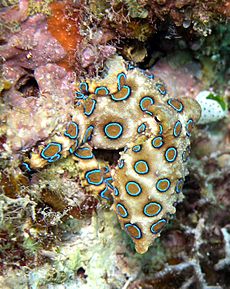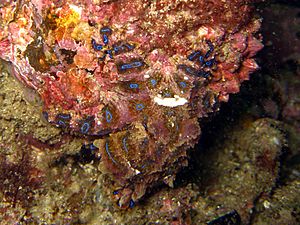Blue-ringed octopus facts for kids
Quick facts for kids Blue-ringed octopus |
|
|---|---|
 |
|
| Greater Blue-ringed Octopus (Hapalochlaena lunulata) |
|
| Scientific classification | |
| Kingdom: | |
| Phylum: | |
| Class: | |
| Order: | |
| Family: |
Octopodidae
|
| Subfamily: |
Octopodinae
|
| Genus: |
Hapalochlaena
Robson, 1929
|
The Blue-ringed octopus (genus Hapalochlaena) is a very venomous octopus. This small cephalopod mollusc lives in warm, shallow reefs. You can find it off the coasts of Australia, New Guinea, Indonesia, and the Philippines. These octopuses usually live for about 1½ years.
Contents
What Does It Look Like?
The Blue-ringed octopus has special blue rings on its body and eight arms. These rings are a warning colouration. They show up when the octopus feels threatened. When it's fully showing its warning, its body turns bright yellow. The blue rings or lines become very clear. This octopus is only about 8 inches (20 cm) wide when its tentacles are spread out.
How Does It Behave?
Blue-ringed octopuses often hide in small cracks in rocks. They are very good at camouflage. This means they can change their skin patterns to blend in with their surroundings. They use special skin cells called chromatophores to do this. Like all octopuses, they can change their body shape easily. This helps them squeeze into tiny spaces, even smaller than themselves. They also pile up rocks outside their hiding spots. This helps keep them safe from animals that might want to eat them.
If a blue-ringed octopus is bothered, it quickly changes color. It turns bright yellow, and its 50 to 60 rings flash a bright, shiny blue. This happens in less than a second. It's a clear warning to stay away. In the greater blue-ringed octopus, these rings have special layers that reflect blue-green light. Dark cells around the rings can expand in one second. This makes the blue rings stand out even more.
The octopus makes its blue rings flash using muscles. Normally, these muscles keep the rings hidden. When the octopus relaxes these muscles and tightens others, the blue color appears. This creates the fast flashing effect.
Like other Octopoda, the blue-ringed octopus swims by pushing water out of a funnel. This is a type of jet propulsion.
What Does It Eat?
The blue-ringed octopus mainly eats small crabs and shrimp. They might also eat small fish if they can catch them. The octopus pounces on its prey. It grabs the prey with its tentacles and pulls it towards its mouth. It uses a hard, bird-like beak to bite through the prey's tough outer shell. Then, it releases its venom. The venom stops the prey's muscles from working, which quickly kills it.
Life Cycle
The mating process for the blue-ringed octopus starts when a male approaches a female. He gently touches her with a special arm called a hectocotylus. The male then grabs the female, sometimes covering her completely. He transfers sperm packets into her body using his hectocotylus. Mating continues until the female decides she has had enough. In some cases, the female has to push the male away. Males will try to mate with other octopuses of their kind, no matter their sex or size. But interactions between two males are usually shorter.
Female blue-ringed octopuses lay only one group of eggs in their lives. This usually happens in late autumn. They lay about 50 eggs. The female then keeps the eggs safe under her arms for about six months. During this time, she does not eat. After the eggs hatch, the mother octopus dies. The new baby octopuses will grow up and be ready to mate by the next year.
Is It Dangerous?
The blue-ringed octopus is small, but it carries very powerful venom. It has enough venom to harm many adult humans within minutes. Its bites are tiny and often don't hurt at first. Many people don't even know they've been bitten until they start having trouble breathing or moving. There is no antivenom for blue-ringed octopus bites yet. This makes it one of the most dangerous animals in the ocean's reefs.
The Venom
The octopus produces venom that contains a powerful substance called tetrodotoxin. This venom can cause serious problems like feeling sick, trouble breathing, and even heart failure. It can also lead to severe paralysis, blindness, and can be deadly very quickly if not treated. If death occurs, it's usually because the muscles needed for breathing stop working.
The main harmful part of the blue-ringed octopus venom is tetrodotoxin. This same toxin is found in pufferfish and some poison dart frogs. Tetrodotoxin is extremely toxic, much more so than cyanide. It blocks signals in the body's nerves. This causes muscles to stop working and breathing to stop within minutes. The tetrodotoxin is made by bacteria that live in the octopus's salivary glands.
You must touch the octopus to be bitten. If it feels threatened, the octopus first tries to swim away. If the danger continues, it will take a defensive pose and show its bright blue rings. Only if an octopus is trapped and touched will a person be in danger of being bitten.
What Happens After a Bite?
Tetrodotoxin causes severe paralysis of the whole body. People who are bitten might be fully awake but unable to breathe. Because of the paralysis, they cannot call for help or show they are in trouble. They stay conscious, similar to how some medicines affect the body. However, this effect is temporary. It will go away after a few hours as the body gets rid of the toxin.
The effects can be more serious for children because they are smaller.
How to Treat a Bite
If someone is bitten, the first thing to do is apply pressure to the wound. Then, start artificial respiration (rescue breathing) as soon as the person's breathing muscles stop working. This often happens within minutes of the bite. Since the venom mainly causes paralysis, people can often be saved if rescue breathing starts quickly. It should be continued until medical help arrives.
It is very important to keep doing rescue breathing without stopping. Continue until the paralysis wears off and the person can breathe on their own. This can be very tiring for one person. Using a bag valve mask can help make it easier until more help arrives.
At the hospital, doctors will place the patient on a medical ventilator. This machine helps them breathe until the body removes the toxin.
Most people who survive the first 24 hours after a bite usually recover completely.
|
See also
 In Spanish: Pulpos de anillos azules para niños
In Spanish: Pulpos de anillos azules para niños



